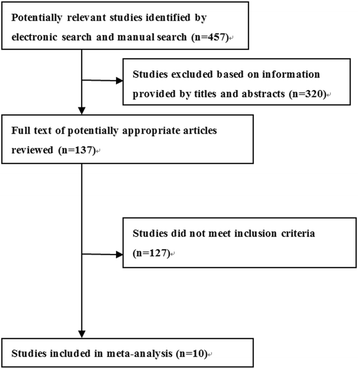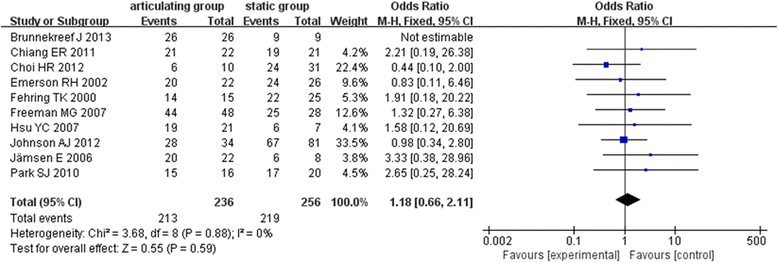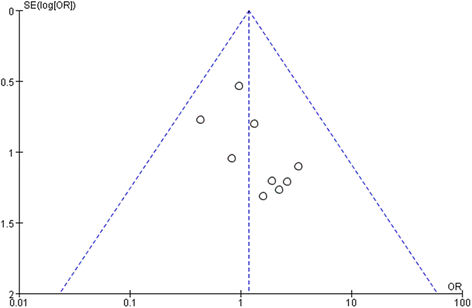Comparison of the efficacy of static versus articular spacers in two-stage revision surgery for the treatment of infection following total knee arthroplasty: a meta-analysis
- PMID: 29041970
- PMCID: PMC5646138
- DOI: 10.1186/s13018-017-0644-6
Comparison of the efficacy of static versus articular spacers in two-stage revision surgery for the treatment of infection following total knee arthroplasty: a meta-analysis
Abstract
Background: The aim of this study was to compare the outcomes of static versus articular spacers in two-stage reimplantation for the treatment of infected total knee arthroplasty (TKA).
Methods: The literature regarding the articulating and static spacers for treating infected TKA were searched in PubMed, Embase, Cochrane Library, Chinese Periodical Full-Text Database of CNKI, and Wanfang database. Data were extracted according to the inclusion and exclusion criteria and analyzed by Review Manager 5.3.
Results: Ten studies were included to this meta-analysis (nine retrospective studies, one prospective study) according to the principle of PICOS. There was no significant difference regarding the eradication rate (P = 0.28) and the American Knee Society knee score (KSS) pain score (P = 0.11) between the articulating and static spacers in the two-stage revision surgery. There was no significant difference regarding quadriceps femoroplasty and tibial tubercle osteotomy between the two groups (P = 0.50). The knee range of motion (ROM), Hospital for Special Surgery (HSS) score, and KSS function score in the articulating group were significantly higher than those in the static group (P < 0.00001).
Conclusion: Articulating spacers can provide better ROM and knee function scores after revision surgery when compared to static spacer while not compromising the infection eradication rate, soft tissue contracture during exclusion period, and knee pain scores.
Keywords: Antibiotic bone cement spacer; Meta-analysis; Periprosthetic infection; Total knee arthroplasty; Two-stage revision arthroplasty.
Conflict of interest statement
Ethics approval and consent to participate
Not applicable.
Consent for publication
Not applicable.
Competing interests
The authors declare that they have no competing interests.
Publisher’s Note
Springer Nature remains neutral with regard to jurisdictional claims in published maps and institutional affiliations.
Figures









Similar articles
-
Short-term Follow-up of Antibiotic-loaded Articulating Cement Spacers in Two-stage Revision of Infected Total Knee Arthroplasty: A Case Series.Orthop Surg. 2018 May;10(2):128-133. doi: 10.1111/os.12381. Epub 2018 May 17. Orthop Surg. 2018. PMID: 29770589 Free PMC article.
-
Treatment of Periprosthetic Knee Infection With a Two-stage Protocol Using Static Spacers.Clin Orthop Relat Res. 2016 Jan;474(1):120-5. doi: 10.1007/s11999-015-4443-2. Clin Orthop Relat Res. 2016. PMID: 26280681 Free PMC article.
-
[Two-stage revision of infected total knee arthroplasty using antibiotic-impregnated articulating cement spacer].Zhongguo Xiu Fu Chong Jian Wai Ke Za Zhi. 2012 Oct;26(10):1169-73. Zhongguo Xiu Fu Chong Jian Wai Ke Za Zhi. 2012. PMID: 23167096 Chinese.
-
Comparison of infection eradication rate of using articulating spacers containing bio-inert materials versus all-cement articulating spacers in revision of infected TKA: a systematic review and meta-analysis.Arch Orthop Trauma Surg. 2019 May;139(5):695-707. doi: 10.1007/s00402-019-03121-x. Epub 2019 Mar 8. Arch Orthop Trauma Surg. 2019. PMID: 30850888
-
Comparison of dynamic and static spacers for the treatment of infections following total knee replacement: a systematic review and meta-analysis.J Orthop Surg Res. 2022 Jul 15;17(1):348. doi: 10.1186/s13018-022-03238-7. J Orthop Surg Res. 2022. PMID: 35840986 Free PMC article.
Cited by
-
Review of recent advances in the diagnosis and management of periprosthetic joint infection after total knee arthroplasty part 2: single-stage or two-stage surgical technique?J Orthop Surg Res. 2024 Oct 12;19(1):643. doi: 10.1186/s13018-024-05152-6. J Orthop Surg Res. 2024. PMID: 39395987 Free PMC article. Review.
-
Temporary arthrodesis through static spacer implantation in two-stage treatment of periprosthetic joint infections of the knee.Oper Orthop Traumatol. 2023 Jun;35(3-4):170-178. doi: 10.1007/s00064-023-00809-7. Epub 2023 May 12. Oper Orthop Traumatol. 2023. PMID: 37171589 Review. English.
-
Application of 3D Printing-Assisted Articulating Spacer in Two-Stage Revision Surgery for Periprosthetic Infection after Total Knee Arthroplasty: A Retrospective Observational Study.Biomed Res Int. 2021 Feb 8;2021:3948638. doi: 10.1155/2021/3948638. eCollection 2021. Biomed Res Int. 2021. PMID: 33628779 Free PMC article.
-
Outcomes of Antibiotic-Impregnated Calcium Sulfate, Reamer-Irrigator-Aspirator, and Locked Intramedullary Static Spacer in the Treatment of Periprosthetic Joint Infection in the Multiply Revised and Infected Knee: A Single-Center Case Series.Arthroplast Today. 2024 Apr 24;27:101370. doi: 10.1016/j.artd.2024.101370. eCollection 2024 Jun. Arthroplast Today. 2024. PMID: 38690098 Free PMC article.
-
Meta-analysis in periprosthetic joint infection: a global bibliometric analysis.J Orthop Surg Res. 2020 Jul 10;15(1):251. doi: 10.1186/s13018-020-01757-9. J Orthop Surg Res. 2020. PMID: 32650802 Free PMC article.
References
-
- Sherrell JC, Fehring TK, Odum S, Hansen E, Zmistowski B, Dennos A, et al. The Chitranjan Ranawat Award: fate of two-stage reimplantation after failed irrigation and debridement for periprosthetic knee infection. Clin Orthop Relat Res. 2011;469(1):18–25. doi: 10.1007/s11999-010-1434-1. - DOI - PMC - PubMed
-
- Lonner JH, Barrack R, Fitzgerald RH Jr, Hanssen AD, Windsor ER. Infection in total knee arthroplasty: part I. Classification, prophylaxis, and diagnosis. American journal of orthopedics (Belle Mead, NJ) 1999;28(9):530-535. - PubMed
Publication types
MeSH terms
LinkOut - more resources
Full Text Sources
Other Literature Sources
Medical

